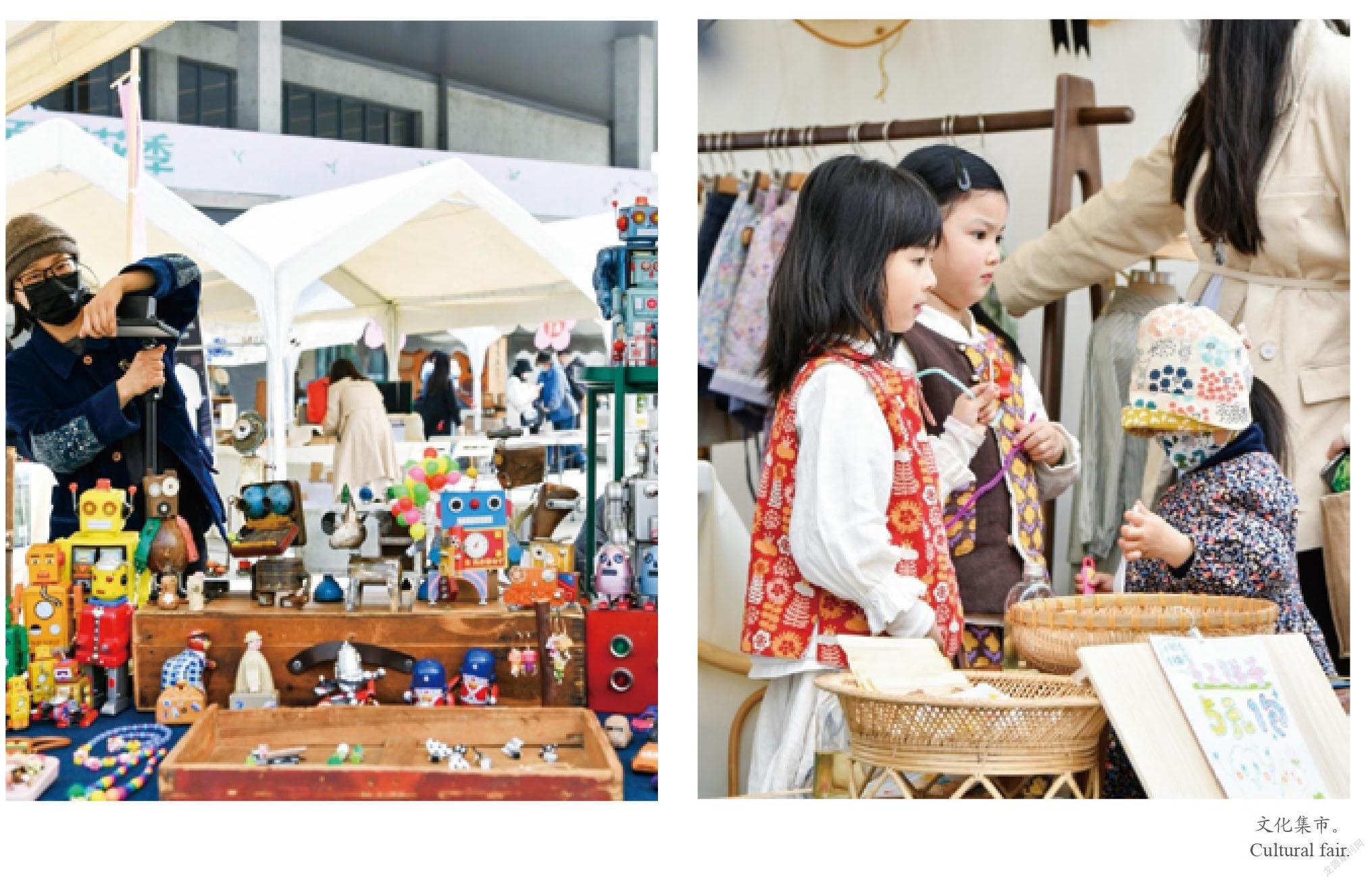在文化集市感受季节之美
郭思珈


經过一段时间的阴雨连绵,心似乎也跟着发了霉。看到这样的好天气,杭州人自然珍重异常,为了不再有“最是人间留不住”之叹,我选择来到杭州良渚文化村,参加大屋顶的系列文化活动,体验一次自然与人文的熏陶。
“大屋顶”是良渚文化艺术中心的别称,由日本著名建筑大师安藤忠雄先生设计。我很喜欢他的一句话:公共建筑的精髓就是能让人聚集在一起。这座建筑也真的在浙江完成了这样的使命,成为无数市民休闲放松的好去处。
建筑内部分为展示栋、文化栋与商业区,外部辉映着大草坪、水台,每到春天樱花烂漫。这里的一百棵纯正吉野樱自日本漂洋过海而来,由安藤先生本人捐赠,他希望美丽的樱花长植在这里,也能长植在来往游客的心中,让每个人能够直面生活的苦难,不忘记最初的理想。
这次活动最热闹非凡的当属“艺术品集市”了。樱花树边搭起了一顶顶小帐篷,这每一顶小帐篷里都有着独一无二的精彩。伴着人群流连于这些摊位之间,真有如在赶一个熙熙攘攘的市集。
你瞧,这一顶帐篷里摆满了精巧的耳环项链戒指,这些首饰都被打造成植物形状,很是精巧。仔细去看,你可以看清楚这朵“玫瑰花”花瓣的重重叠叠,这枚“枫叶”的叶茎叶脉,这只“蝴蝶”的翅膀纹路。店主小袁告诉我们,这些首饰都是用真的植物与动物制成的,从大自然中取材,人工上色着料,他把这种工艺称作“电铸艺术”。
谈起他的作品,小袁很是骄傲。他本是学园艺出身,在与大自然的互动中产生了要把美保留下来的想法。他转身投向艺术,每一件作品都经过几天甚至几个月的精心雕琢而成,这些作品承载了他对美的执着与追求。在制作的过程中,小袁也在逐步进行着自己的美感积累,他很热爱自己的这份工作。
我们还可以在不同的帐篷中看到用植物取色染成的衣服、戴在手上随风而动的戒指、美丽精巧的香薰制品、造型奇特的袜子、牛仔布缝制的搞笑娃娃。要是逛得饿了渴了,我们也可以在另一些帐篷中品尝到带有艺术气息的手磨咖啡、自制啤酒、鲜榨果汁,可以吃到现场加工的鲷鱼烧、手工面包。在这樱花集市中,吸引我们的不仅仅是一件件艺术品,其实也有艺术品背后那一位位热爱生活的人,聆听着他们对自己创作理念热情洋溢的介绍,我们不禁被感染,感叹道,真好,这世界上原来有这么多有趣的人呐。
这样一个天气晴好的日子,逛累了这些艺术品店铺,不妨去旁边的大草坪上散散步。经过雨水连绵的滋润,恰逢暖阳照耀,万物都焕发了生机。草更绿了,景色更美了。水台里的清水在微风的吹动下也泛着层层涟漪。游客们三三两两,有人席地而坐,与朋友家人畅谈;有人在树下摆着各种姿势,让自己的同伴用相机记录下这个美好瞬间;有人在地上铺了席子,拿出食物准备野餐。小孩子们更是兴奋,有的在吹泡泡,有的在放风筝,有的在追逐打闹。远远看去,俨然一幅岁月静好图。
不一会儿,大草坪上的摇摆舞开始了。主持人劲头十足地教着大家最简单的舞步,边示范边喊着口令 :“后—后—左—右—two—three—”,一开始大家还真有点放不开,但是现场气氛在幽默诙谐的主持人的带动下渐渐活跃起来,大家开始两两组合,跟着主持人的口令,有规律地前后左右摇摆。关于摇摆舞还有一个有趣的说法:“要把舞跳好,那就先把你的舞伴逗乐。”跳舞时,一方可以做一些夸张的动作或扮鬼脸来逗舞伴开心。这种不受规则约束,以开心为目的的舞蹈深受大家欢迎,大家笑着、跳着,越来越多的人加入这个队伍,甚至有的陌生人也互相组起了队,在尽情的摇摆中,释放生活的压力,收获满满的开心与幸福。
建筑内部有咖啡吧、文创区,还有一个温馨的小图书馆。图书馆里有五万余册藏书,以文史哲为主,兼顾文艺与学术,并且免费向市民开放。这里也会不定期举办文艺沙龙,曾邀请过麦家、阿乙、刘斌等十几位著名作家进行读书分享。这是一方心灵的港湾,这里没有城市的喧嚣,没有世俗的纷杂,知识的有缘人自会寻到这个港湾,泡上一杯咖啡,在某个角落里摊开一本书,尽情遨游于另一个世界,获得一种难得的内心宁静,这实在是一件再幸福不过的事。
摄影展览也是不能错过的精彩。二十世纪八十年代,日本摄影师秋山亮二先生来到中国,辗转几个城市,用镜头记录下了那个年代各地小朋友们的童年生活。在一张张照片中,我看到了那些记忆中久违了的事物:红领巾、绿军装、小红花、跳格子,也被一幅幅照片中儿童纯真的脸所感染,更能感受到照片背后,拍摄者的那双发现美的眼睛以及赤诚的心灵。这世间的美好是不分国界与种族的。
此番踏足良渚,不负美好时光。愿每个人心中的春天永不过季。
The Beauty of Spring at a Cultural Fair
By Guo Sijia
After a period of rainy days, my mood seems to have mildewed as well. Seeing such a good weather, I decide to come to the Liangzhu Culture Village and be part of a series of cultural activities held in the “Big Roof”.
Designed by Tadao Ando, a top architect and Pritzker Prize winner, the “Big Roof” is the nickname of the Liangzhu Culture and Art Center, which was officially opened to the public on June 5, 2016, and named one of the top ten “new landmarks” in Hangzhou in 2021. As Ando once said, “… architecture is fundamentally a public space where people can gather and communicate …”. The “Big Roof” has achieved exactly that mission, becoming one of the most popular places for local residents.
Inside the “Big Roof”, it is divided into the exhibition, culture and business areas, while a big lawn and a fountain lie on the outside. Each spring, cherry blossoms can be seen all around the place. In fact, the 100 Somei Yoshino cherry trees came from Japan and were donated by Mr. Ando himself. He hoped that the beautiful cherry trees would grow in the hearts of tourists, and everyone could face the hardships of life and never forget their dreams.
The most jolly event is the Artworks Fair. Small tents have been set up near the cherry trees, and each tent had its own unique charm. Walking among these stalls with the crowd is like walking in a bustling bazaar.
One of the tents is filled with elaborate earrings, necklaces and rings, all created in the shape of plants, quite elaborate. If you look carefully, you can actually see the overlapping of the petals of a "rose", the veins of the leaf stem of a "maple leaf" and the texture of the wing of a "butterfly". The owner, a Mr. Yuan, says the jewelry is made from real plants and animals and painted by hand, a process he calls "electroforming art."
Speaking of his works, Mr. Yuan is full of pride. Originally a student of horticulture, he conceived the idea of preserving beauty in his interactions with nature, which led him to art. Every piece of his work has been elaborately carved, taking him several days or even months. In the process, he is also gradually developing his own aesthetics. He loves his current job very much.
In the other tents, you can also see clothes dyed with the colors of plants, rings that move with winds, drink hand-ground coffee, homemade beer, fresh juice, and taste grilled snapper and handmade bread. At the fair, what is even more attractive is the people behind each artwork, their enthusiasm and love towards their works.
If you are tired of visiting all the stalls, you might as well take a stroll on the big lawn sitting just beside. Tourists sit on the grass in twos and threes, chatting with friends and family. Some pose under the tree for their partner to record the moment with a camera. Some brings out food and snacks and put it on a mat for a picnic. Children are always more excited, some blowing bubbles, some flying kites and some chasing each other.
Inside the building, there is a coffee bar, an area for cultural and creative products, and a cozy little library. The library has a collection of more than 50,000 volumes, focusing on literature, history and philosophy, open to the public for free. Literary salons have been held here from time to time, and more than a dozen famous writers such as Mai Jia, A Yi, Liu Bin and Wu Xiaobo have been invited to share their books. This is a harbor for the soul: there is no hustle and bustle of the city, there is no worldly chaos, and for people seeking knowledge, they will surely find it.
The photography exhibition is another must-see. In the 1980s, Japanese photographer Ryoji Akiyama came to China and recorded the lives of children from all over the country.
All in all, a spring outing in Liangzhu is definitely worth the effort.

